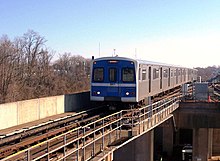Baltimore Metro
The Baltimore Metro (also Metro Subway ) is a public transport system for the city of Baltimore in the US state of Maryland , which went into operation in 1983 after six years of construction. The metro is operated by the Maryland Transit Administration .
history
After initial plans for a metro in Baltimore in 1966, which provided for six lines, the first section of the metro in the form of a cross-city link was not put into operation until 1983, after the decline in public funds for transport projects and the rise in construction costs . Initially, the subway only had nine stations between Reisterstown Plaza and Charles Center. In 1987 the route was extended to the northwest by three stations to Owings Mills and in 1994 to the southeast to the Johns Hopkins Hospital .
route
The current route network has 14 stations over a length of 24.5 kilometers (15.5 miles). Ten kilometers of this run underground, 3.5 kilometers elevated and eleven kilometers at ground level. The travel time between the terminus Owings Mills and Johns Hopkins Hospital is about half an hour.
In the rush hour trains every eight, in late traffic every eleven minutes. On weekends, trains run every 15 minutes. The trains run from 5 a.m. to midnight during the week and from 6 a.m. to midnight on the weekend.
vehicles
The vehicles of the Baltimore Metro were built by the Budd Company and correspond to those of the Miami Metro , which were commissioned at the same time.
A car is 22.9 meters long, 3.05 meters wide, 3.35 meters high and weighs 35 tons. Each vehicle has 76 seats and 90 standing places, air conditioning , floor heating and loudspeaker systems, which in emergencies, since they can be used on both sides, ensure communication between drivers and passengers. The train length is two, four or six cars, as two cars are permanently coupled. The maximum speed is around 113 km / h, the average cruising speed around 48 km / h.
The MTA currently owns 100 cars, 54 of which are in operation at peak times.
In July 2017, the Maryland Transit Administration awarded a $ 400.5 million contract to supply vehicles and signaling systems. The supplier is the Hitachi Ansaldo Baltimore Rail Partners joint venture of Hitachi Rail Italy, which will supply 78 metro cars, and Ansaldo STS's US subsidiary, which will replace the existing signaling system with CBTC. The steel cars will be built at HRI's Miami factory. Each vehicle has space for 196 passengers, including 76 seats. The two-car units will run in multiple traction and will be equipped with WiFi, a passenger information system and a fiberglass front with LED lighting. The first vehicles are scheduled to go into service in 2021.
Individual evidence
- ↑ Metro Report International, July 27, 2017: [Hitachi to supply Baltimore metro trains and signaling http://www.metro-report.com/news/news-by-region/americas/single-view/view/hitachi-to -supply-baltimore-metro-trains-and-signaling.html ]
- ↑ MTA press release, July 28, 2017: [MDOT MTA Wins Approval for $ 400.5 Million Purchase of Metro SubwayLink Railcars and Train Control System https://mta.maryland.gov/content/mdot-mta-wins-approval-4005-million- purchase-metro-subwaylink-railcars-and-train-control ]

